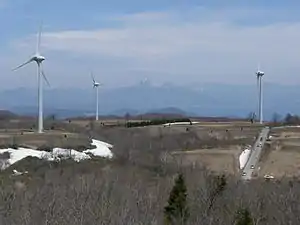Wind power in Japan
In Japan's electricity sector wind power generates a small proportion of the country's electricity. As of 2019, the country had a total installed capacity of 3,923 MW. Government targets for wind power deployment are relatively low when compared to other countries, at 1.7% of electricity production by 2030.[1] It has been estimated that Japan has the potential for 144 GW for onshore wind and 608 GW of offshore wind capacity.[2]

Statistics
| Year | Capacity[3] | Change | % Change |
|---|---|---|---|
| 2000 | 136 | ||
| 2001 | 302 | 166 | 122.06% |
| 2002 | 338 | 36 | 11.92% |
| 2003 | 580 | 242 | 71.60% |
| 2004 | 809 | 229 | 39.48% |
| 2005 | 1,049 | 240 | 29.67% |
| 2006 | 1,309 | 260 | 24.79% |
| 2007 | 1,538 | 229 | 17.49% |
| 2008 | 1,882 | 344 | 22.37% |
| 2009 | 2,186 | 304 | 16.15% |
| 2010 | 2,475 | 289 | 13.22% |
| 2011 | 2,556 | 81 | 3.27% |
| 2012 | 2,641 | 86 | 3.33% |
| 2013 | 2,715 | 73 | 2.8% |
| 2014 | 2,921 | 214 | 7.59% |
| 2015 | 3,167 | 246 | 8.42% |
| 2016[4] | 3,234 | 164 | 2.12% |
| 2017[4] | 3,400 | 170 | 5.13% |
| 2018[4] | 3,654 | 254 | 7.47% |
| 2019[4] | 3,923 | 269 | 7.36% |
Government incentives
As of 2017, the feed-in tariff per kWh are 21 yen for onshore and 36 yen for offshore.[5]
Notable projects
The Shin Izumo Wind Farm owned by Eurus Energy was the largest wind farm in Japan as of 2011, comprising 26 turbines with a total nameplate capacity of 78 megawatts.[6]
The Shin Aoyama Wind Farm owned by C-tech is currently the largest wind farm in Japan, as of February 2018. It comprises 40 turbines with a total nameplate capacity of 80 megawatts. The amount of electrical power that can be generated is equivalent to the annual consumption of about 44,000 ordinary households.[7]
The Yurihonjo Offshore Wind Farm located in Akita Prefecture is expected to begin construction in 2021. It will comprise 70-90 turbines with a proposed capacity of as much as 1000 megawatts. Upon completion, its capacity is projected to be the largest offshore wind farm in Japan.[8]
In 2011, Japan stated plans to build a pilot floating wind farm, with six 2-megawatt turbines, off the Fukushima coast.[9] After the evaluation phase is complete in 2016, "Japan plans to build as many as 80 floating wind turbines off Fukushima by 2020."[9]
In 2013, a floating offshore wind turbine was tested about 1 km off the coast of the island of Kabajima in Nagasaki Prefecture. It was a part of a Japanese government test project.[10] This was the first of its kind in Japan.
See also
References
- "Japan behind on wind power | The Japan Times". The Japan Times. Retrieved 14 March 2018.
- Watanabe, Chisaki (2014-02-27). "GE Says Japan Has More Potential to Harness Wind Power". Bloomberg.
- "Japan". Japan Wind Energy Association. March 2009. Retrieved 2014-02-05.
- "Installed Capacity by the end of 2019|Wind Energy International". library.wwindea.org/. Retrieved 13 June 2020.
- "Japan accelerates wind power development as govt support pays off: study". Reuters. 28 February 2017. Retrieved 1 March 2017.
- "May 21, 2009 – Japan's largest-ever Wind Farm completed". Eurus Energy Holdings Corporation. 2009-03-21. Retrieved 2011-04-18.
- "Creating new value through collaborative creation: Wind turbines using digital technology". Hitachi. March 2018. Retrieved 2019-01-09.
- "Wind Power Plant in Akita Might Have Output of 1GW". NikkeiXTech. April 2018. Retrieved 2019-02-08.
- "Japan Plans Floating Wind Power Plant". Breakbulk. 2011-09-16. Retrieved 2011-10-12.
- "Project tests viability of offshore floating wind turbines," Japan Times. 4 April 2013; retrieved 2013-4-30.
External links
| Wikimedia Commons has media related to Wind power in Japan. |
- Japan Wind Power Association (in English and Japanese)
- Japan Wind Energy Association (in Japanese)
- New Energy Foundation (in Japanese)
- New Energy and Industrial Technology Development Organization (in Japanese and English)
- Electrical Japan: Google Maps of Power Stations (Wind) (in Japanese)